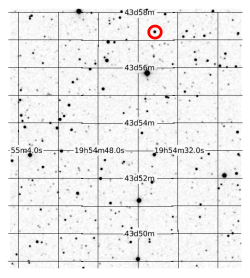| Observation data Epoch J2000.0 Equinox J2000.0 | |
|---|---|
| Constellation | Cygnus [2] |
| Right ascension | 19h 54m 36.6535s [3] |
| Declination | +43° 57′ 18.026″ [3] |
| Apparent magnitude (V) | 15.29 [4] |
| Characteristics | |
| Evolutionary stage | Main sequence [3] |
| Spectral type | M1V [5] |
| Astrometry | |
| Proper motion (μ) | RA: 2.171(18) mas/yr [3] Dec.: −4.363(20) mas/yr [3] |
| Parallax (π) | 5.6336±0.0169 mas [3] |
| Distance | 579 ± 2 ly (177.5 ± 0.5 pc) |
| Details | |
| Mass | 0.544 ± 0.02 [5] M☉ |
| Radius | 0.523 ± 0.02 [5] R☉ |
| Luminosity (bolometric) | 0.055 +0.011 −0.006 [5] L☉ |
| Temperature | 3755 ± 90 [5] K |
| Metallicity [Fe/H] | −0.26 ± 0.12 [5] dex |
| Rotation | 34.404±0.075 days [6] |
| Age | 4.0 ± 0.6 [5] Gyr |
| Other designations | |
| KIC 8120608 [7] , KOI-571, 2MASS J19543665+4357180, Gaia DR2 2079000330051813504 | |
| Database references | |
| SIMBAD | data |
Kepler-186 is a main-sequence M1-type dwarf star, located 177.5 parsecs (579 light years) away in the constellation of Cygnus. The star is slightly cooler than the sun, with roughly half its metallicity. It is known to have five planets, including the first Earth-sized world discovered in the habitable zone: Kepler-186f. [8] The star hosts four other planets discovered so far, though they all orbit interior to the habitable zone.
Contents
- Naming
- Kepler project
- Outside the Kepler project
- Star
- Planetary system
- See also
- References
- External links
Within two first years of gathered data, the signals of four inner planetary candidates were found. Discussion of planets in the system was taking place in August and November 2013. [9] In February 2014, those planets were confirmed through the "verification by multiplicity" method. The fifth outermost candidate was confirmed in the same manner in April 2014. [10] The possibility that the signals in the light curve of the star were actually from something else has been ruled out by an investigation with the W. M. Keck and Gemini Observatories, using speckle imaging and adaptive optics techniques, which, while unable to resolve the planets, were able to rule out other possibilities than the system of planets. [11]



